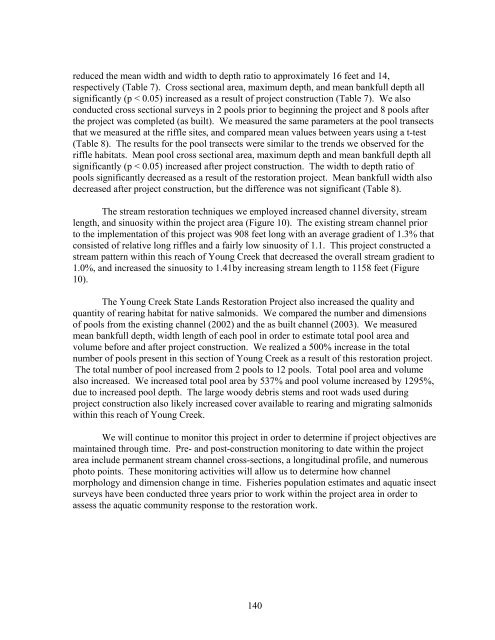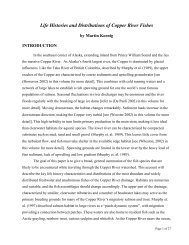Mitigation for the Construction and Operation of Libby Dam
Mitigation for the Construction and Operation of Libby Dam
Mitigation for the Construction and Operation of Libby Dam
You also want an ePaper? Increase the reach of your titles
YUMPU automatically turns print PDFs into web optimized ePapers that Google loves.
educed <strong>the</strong> mean width <strong>and</strong> width to depth ratio to approximately 16 feet <strong>and</strong> 14,<br />
respectively (Table 7). Cross sectional area, maximum depth, <strong>and</strong> mean bankfull depth all<br />
significantly (p < 0.05) increased as a result <strong>of</strong> project construction (Table 7). We also<br />
conducted cross sectional surveys in 2 pools prior to beginning <strong>the</strong> project <strong>and</strong> 8 pools after<br />
<strong>the</strong> project was completed (as built). We measured <strong>the</strong> same parameters at <strong>the</strong> pool transects<br />
that we measured at <strong>the</strong> riffle sites, <strong>and</strong> compared mean values between years using a t-test<br />
(Table 8). The results <strong>for</strong> <strong>the</strong> pool transects were similar to <strong>the</strong> trends we observed <strong>for</strong> <strong>the</strong><br />
riffle habitats. Mean pool cross sectional area, maximum depth <strong>and</strong> mean bankfull depth all<br />
significantly (p < 0.05) increased after project construction. The width to depth ratio <strong>of</strong><br />
pools significantly decreased as a result <strong>of</strong> <strong>the</strong> restoration project. Mean bankfull width also<br />
decreased after project construction, but <strong>the</strong> difference was not significant (Table 8).<br />
The stream restoration techniques we employed increased channel diversity, stream<br />
length, <strong>and</strong> sinuosity within <strong>the</strong> project area (Figure 10). The existing stream channel prior<br />
to <strong>the</strong> implementation <strong>of</strong> this project was 908 feet long with an average gradient <strong>of</strong> 1.3% that<br />
consisted <strong>of</strong> relative long riffles <strong>and</strong> a fairly low sinuosity <strong>of</strong> 1.1. This project constructed a<br />
stream pattern within this reach <strong>of</strong> Young Creek that decreased <strong>the</strong> overall stream gradient to<br />
1.0%, <strong>and</strong> increased <strong>the</strong> sinuosity to 1.41by increasing stream length to 1158 feet (Figure<br />
10).<br />
The Young Creek State L<strong>and</strong>s Restoration Project also increased <strong>the</strong> quality <strong>and</strong><br />
quantity <strong>of</strong> rearing habitat <strong>for</strong> native salmonids. We compared <strong>the</strong> number <strong>and</strong> dimensions<br />
<strong>of</strong> pools from <strong>the</strong> existing channel (2002) <strong>and</strong> <strong>the</strong> as built channel (2003). We measured<br />
mean bankfull depth, width length <strong>of</strong> each pool in order to estimate total pool area <strong>and</strong><br />
volume be<strong>for</strong>e <strong>and</strong> after project construction. We realized a 500% increase in <strong>the</strong> total<br />
number <strong>of</strong> pools present in this section <strong>of</strong> Young Creek as a result <strong>of</strong> this restoration project.<br />
The total number <strong>of</strong> pool increased from 2 pools to 12 pools. Total pool area <strong>and</strong> volume<br />
also increased. We increased total pool area by 537% <strong>and</strong> pool volume increased by 1295%,<br />
due to increased pool depth. The large woody debris stems <strong>and</strong> root wads used during<br />
project construction also likely increased cover available to rearing <strong>and</strong> migrating salmonids<br />
within this reach <strong>of</strong> Young Creek.<br />
We will continue to monitor this project in order to determine if project objectives are<br />
maintained through time. Pre- <strong>and</strong> post-construction monitoring to date within <strong>the</strong> project<br />
area include permanent stream channel cross-sections, a longitudinal pr<strong>of</strong>ile, <strong>and</strong> numerous<br />
photo points. These monitoring activities will allow us to determine how channel<br />
morphology <strong>and</strong> dimension change in time. Fisheries population estimates <strong>and</strong> aquatic insect<br />
surveys have been conducted three years prior to work within <strong>the</strong> project area in order to<br />
assess <strong>the</strong> aquatic community response to <strong>the</strong> restoration work.<br />
140
















